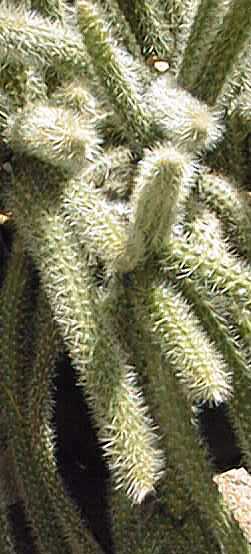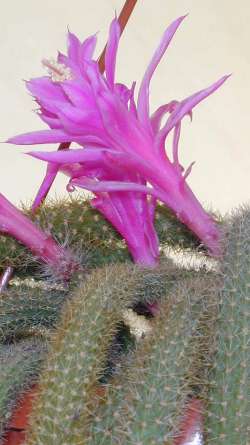Rat Tail Cactus
Scientific Name: Disocactus flagelliformis (L.) Lem.
Synonym: Aporocactus flagelliformis, Aporocactus flagelliformis var. leptophis , Aporocactus flagriformis, Aporocactus leptophis, Cactus flagelliformis, Cereus flagelliformis, Cereus flagriformis, Cereus leptophis
Family: Cactaceae
USDA: 10-12
Frost Tolerance: Keep above 35°F (3°C), does not tolerate any frost.
Heat Tolerance: Protect from direct sun, does better inside
Sun Exposure: Light shade to shade, if any direct sun, morning sun only.
Origin: Highland plateaus of Mexico (Oaxaca, Hidalgo), but cilutivated throughout Latin America
Growth Habits: Epiphytic cactus, with long hanging stems, up to 4 feet long (120 cm) or more, up to 1 inch thick (2.5 cm); 7 to 14 ribs; 15 or more yellow spines per areole.
Watering Needs: Keep the soil mixture moist all the time. Water abundantly in summer. Needs good drainage
Propagation: Cuttings that bloom in 2-3 years, or seeds

The plants found as "Aporocactus flagriformis", have wider stems, 0.4 to 1 inch in diameter (1-2.5 cm); 7 to 12 ribs, 4 to 5 central spines, and 6 to 8 radials.
Aporocactus leptophis has stems 0.3 to 0.4 inch in diameter (7-10 mm); 7 or 8 ribs; 9 to 14 radials.
Blooming Habits:
The bright pink flowers 1.5 inches long, 2.5 inches wide (4 by 6 cm), are produced along the stems, in spring and summer are sometimes followed by small red fruits. In the wild, they are pollinated by hummingbirds, but in cultivation, they generally need to be hand pollinated.
Culture:
The name 'Aporocactus' comes from the Greek for "Cactus that is not penetrable".
This cactus is epiphytic in the wild (it grows in trees). It is perfectly adapted to hanging baskets. Use normal potting soil, it likes an acid soil. Morning sun is ideal.
.
The Aporocactus is sensitive to scales and mealybugs. Because of the density of the spines and the fact that it is not always possible to get a good look at a hanging plants, most infestations get overlooked. It is a good idea to make a point to check regularly. The only recourse is to use a systemic insecticide.
Propagation:
Stems can be cut, let dry for a few day so that the cut starts healing, and replanted. The best time to do it is in early summer.
Desert-Tropicals is dedicated to provide gardening advice, gardening ideas, and information about flower of all kind for landscape and collections.We try to check carefully the identification of the plants on the illustrations as well as the other information from the page, but occasionally errors do occur. if you notice anything that needs to be changed please contact us.Thanks.
© 1998-2020 Philippe Faucon, All Rights Reserved.
